|
 Hygrophorus carcharias Hygrophorus carcharias
BiostatusPresent in region - Indigenous. Endemic
Images (click to enlarge)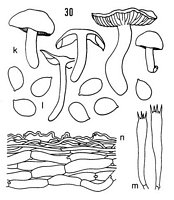
Caption: Hygrophorus carcharias Hk. (type): k. carpophores. - 1. spores. - m. basidia. - n. cuticle | 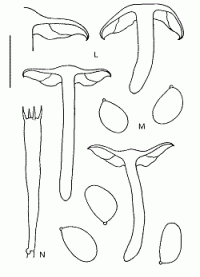
Caption: Fig. 42 Hygrophorus carcharias Horak. (L-N: PDD 27089, type):
L. basidiomes. M. spores. N. basidia | 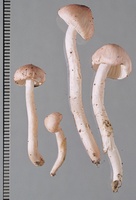
Caption: ZT71-076
Owner: E. Horak: © Creative Commons Attribution-Noncommercial 3.0 New Zealand | 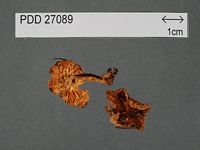
Caption: Dried type specimen
Owner: Herb PDD | 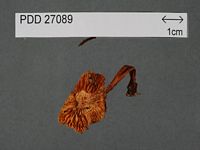
Caption: Dried type specimen
Owner: Herb PDD |
Article: Horak, E. (1990). Monograph of the New Zealand Hygrophoraceae (Agaricales). New Zealand Journal of Botany 28(3): 255-306 (http://www.rsnz.org/publish/abstracts.php).
Description: Pileus 40 mm, hemispherical or convex becoming umbonate to expanded; pallid
while turning pale argillaceous or tan; viscid when moist, glabrous, hygrophanous,
slightly striate at margin. –Lamellae 15-30 (l-5) crowded, adnate to emarginate-adnate;
whitish turning pale yellow, edge concolorous, entire. - Stipe 15-55 x 3-8 mm,
cylindrical, equal; white; dry, longitudinally fibrillose or minutely squamulose,
solid, single or caespitose. - Context white. - Odour changing from fruity to
unpleasant like Cystoderma carcharias (Fr.). - Taste mild. - Chemical
reactions on pileus: KOH - negative. : Spores 6. 5-8 x 4.5-5 um, ovoid to drop-shaped.
-Basidia 38-55 x 5-7 um, 4-spored. - Cystidia absent.-Pileipellis an ixocutis
of cylindrical, repent, interwoven hyphae (2-5 um diam.), membrane gelatinised,
plasmatic pigment present; clamp connections present (Pl. 1, Fig. 7).
Habitat: ECOLOGY: Scattered; saprobic on soil among litter in broadleaved and conifer
forests (Agathis australis, Dacrycarpus dacrydioides). May-July.
Distribution: DISTRIBUTION: NZ (NA, T, O).
Notes: Hygrophorus carcharias is best recognised by its comparatively robust
basidiomes of pale cream or ivory colour in all parts. As the name indicates,
the identification is readily accomplished by the strong odour (ranging from
unpleasant to aromatic-fragrant depending on age). The prominently larmiform
spores easily distinguish H. carcharias from all other recorded New Zealand
Hygrophori.
Article: Horak, E. (1973). Fungi Agaricini Novazelandiae I-V. Beihefte zur Nova Hedwigia 43: 200 p.
Description: Pileus 10-40 mm diam., hemispherical or convex when young becoming umbonate and expanded, whitish or creamy turning pallid argillaceous, viscid when moist, glabrous, hygrophanous and slightly striated at the margin Lamellae adnate to emarginate-adnate, whitish-creamy turning yellowish close, gill edge concolorous, even. Stipe 15-55 x 3-8 mm, cylindric, equal, white, dry, longitudinally fibrillose or even minutely squamulose, solid, mostly single. Context white, stuffed in the stipe. Taste mild. Odor changing from fruity to unpleasant (like Cystoderma carcharias [Fries]). Chemical reactions on pileus: KOH - negative.
Spores 6.5-8 x 4.5-5 µm, ovoid, smooth, inamyloid. Basidia 38-48 x 6-7 µm, 4-spored. Cystidia lacking. Cuticle an ixocutis consisting of repent, gelatinized, cylindric hyphae (2-5 µm diam.). Clamp connections numerous.
Habitat: In soil under Podocarpus, Dacrydium, Beilschmiedia and different tree-ferns. New Zealand.
|